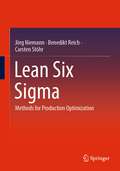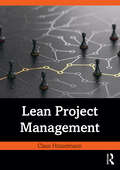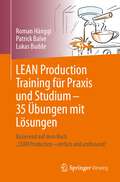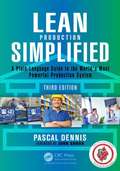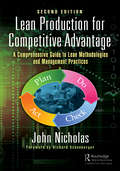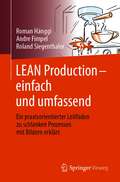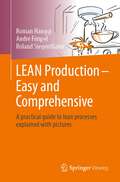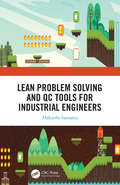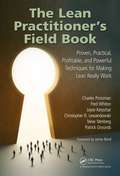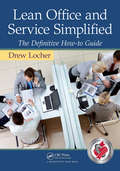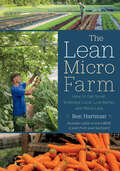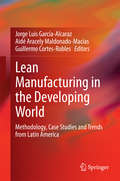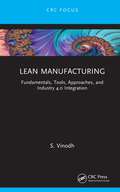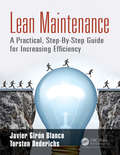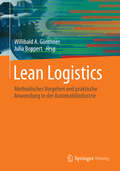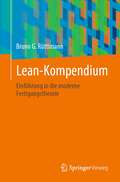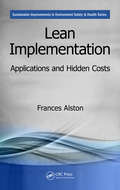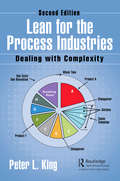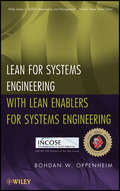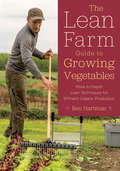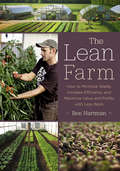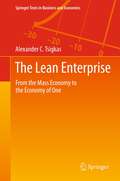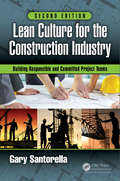- Table View
- List View
Lean Six Sigma: Methods for Production Optimization
by Jörg Niemann Benedikt Reich Carsten StöhrThe Lean Six Sigma Workshop describes important and practically relevant methods and tools for optimizing industrial production structures. In addition to theoretical foundations, the book provides extensive hands-on exercise materials with solutions for each method, ensuring application-oriented knowledge transfer. The book particularly assists educators and learners in preparing and conducting entire teaching units, which can be deepened and practically applied through 13 workshops as group activities.The playful application of theory over multiple game rounds enables learners to use the methods in practice and apply gained insights in an industrial setting.
Lean Project Management: This Book Includes: Lean Guide + Agile Project Management. Practical Guide For Managing Projects, Productivity, Profits Of Enterprises Or Startups With Lean, Scrum, Agile
by Claus HüsselmannMany organisations face the challenge of making their project management more agile. However, the circumstances are often not suitable for this: The desired agility either does not fit the existing projects, or there is a lack of sufficient systematics. Lean Project Management shows how the advantages of different Lean Project Management methods – adaptive, targeted and flexible – can be combined. In addition to the established methods of classic and agile project management, proven methods and tools from Lean Management are used and further developed with a view to the requirements of project management (such as Gemba, 5S and more). The book shows how an organisation can systematically professionalise its project management, and make it more flexible in a targeted manner, in order to achieve more value with less effort. Aimed at students on postgraduate courses in business and project management as well as professional project managers working in organisations both large and small, Lean Project Management is a clear and comprehensive guide to combining the best methods to achieve optimal results.
LEAN Production Training für Praxis und Studium – 35 Übungen mit Lösungen: Basierend auf dem Buch „LEAN Production – einfach und umfassend“
by Roman Hänggi Patrick Balve Lukas BuddeKeine Produktion ist perfekt. In jedem Prozess schleicht sich Verschwendung ein. Sie macht ihn langsam und teuer. Ware liegt im Lager herum, die Fertigung findet in unnötig großen Losen statt oder Mitarbeiter warten unproduktiv, um ein nächstes Teil zu produzieren. Das Ergebnis sind hohe Produktionskosten und enttäuschte Kunden.Lean Production geht nun diese Verschwendungen in allen Prozessen an. Aber wie setzt man nun die verschiedensten Lean Prinzipien und Methoden konkret um? Der Erfolg von Lean Production liegt jedoch im Tun und gerade da setzt das Buch an. Die 35 Übungen aus der Praxis zeigen detailliert auf, wie die Lean Ansätze angewendet und erfolgreich umgesetzt werden. Die Lösungen werden mit Praxis-Tipps zur Umsetzung aus der umfassenden Erfahrung der Autoren ergänzt. Die Übungen werden in der LeanClean AG anschaulich mit vielen Bildern und Diagrammen umgesetzt – konkret, einfach undumfassend erklärt.
Lean Production Simplified: A Plain-Language Guide To The World's Most Powerful Production System
by Pascal DennisLean Production Simplified, Third Edition is a plain language guide to the Lean production system written for the practitioner by a practitioner. It delivers a comprehensive insider's view of Lean manufacturing. Organized around the image of the house of Lean production, the book helps the reader grasp both the system as a whole and the factors that animate it.
Lean Production for Competitive Advantage: A Comprehensive Guide to Lean Methodologies and Management Practices, Second Edition
by John NicholasThe second edition will include four new topics that fully address the scope of Lean: Hoshin Kanri (HK), Managing for Daily Improvement (MDI), Production Preparation Process (3P), and Lean in project management (especially for projects in product development). HK is a management planning process that evolved in Japan concurrent with Lean and early adopters employed it. MDI addresses the 5th S (sustain) in the 5S process. Together, HK and MDI answer questions such as: How is Lean tied to strategic planning? What is the role of management in Lean? How are daily improvements tied to organizational goals? and How are improvements sustained? The two topics address Lean as a "culture."
LEAN Production – einfach und umfassend: Ein praxisorientierter Leitfaden zu schlanken Prozessen mit Bildern erklärt
by Roman Hänggi André Fimpel Roland SiegenthalerKeine Produktion ist perfekt. Im Prozess schleicht sich stets Verschwendung ein, macht ihn langsam, träge und teuer. Ware liegt im Lager herum, die Fertigung findet in unnötig großen Losen statt, Transporte sind erforderlich oder Mitarbeiter warten unproduktiv, um ein nächstes Teil einzuspannen. Das Ergebnis sind hohe Produktionskosten und enttäuschte Kunden.Die Lean-Bewegung hat sich zum Ziel gesetzt Verschwendung aufzudecken, sie zu hinterfragen und zu beseitigen. Dieses Buch vermittelt dir die theoretischen Grundlagen, aber auch die praktischen Werkzeuge, um Produktionsprozesse so schlank und wertschöpfend wie möglich zu gestalten. Weil wir alle Geschichten lieben ist jede Methode unterhaltsam in eine Story verpackt. In diesem Buch lebt ein Barista der täglich Marathondistanzen laufen muss, der Tassen-Tim kämpft mit Überproduktion und die LeanClean AG zählt auf deine Unterstützung, um mit Wertstromanalyse, Spaghetti-Diagramm, 5S oder Kanban die Staubsaugerproduktion auf maximale Wertschöpfung zu trimmen. Zu jedem Thema gibt's unsere Praxis-Tipps. Sie sind die Erkenntnis aus unseren Lean-Projekten der vergangenen 20 Jahre. Sie werden dir helfen, deine Lean-Initiativen noch effektiver und erfolgreicher umzusetzen.
LEAN Production – Easy and Comprehensive: A practical guide to lean processes explained with pictures
by Roman Hänggi André Fimpel Roland SiegenthalerNo production is perfect. Waste always creeps into the processes, makes them slow, sluggish and expensive. Parts and material pile up in the warehouse, production takes place in unnecessarily large batches, transport is taking time, employees wait unproductively for their next task or products ship too late. The result is high production costs and disappointed customers.The Lean movement has set itself the goal of uncovering waste, question it and eliminate it.This book will explain in a simple and comprehensive way the Lean principles as well as the practical tools to make production processes as lean and value-added as possible. Because we all love stories, each method is entertainingly wrapped in an illustrated story. In this book, a barista who has to run marathon distances every day, the cup Tim struggles with overproduction and the LeanClean Inc. counts on your support to trim the vacuum cleaner production to maximum value creation with value stream mapping, spaghetti diagram, 5S or Kanban. For each topic, you will find our practical tips. They are the lessons learned from our Lean projects over the past 20 years in many countries. They will help you to implement your Lean initiatives even more effectively and successfully.
Lean Problem Solving and QC Tools for Industrial Engineers
by Maharshi SamantaThe manufacturing and service sector needs to resolve a lot of issues relating to products, process and service in everyday operation. Successful resolution depends on the methodology, rigor and systematic implementation techniques. The essential purpose of this book is to impart the necessary knowledge to the reader about concepts in six sigma problem-solving providing sufficient knowledge of problem lifecycle and ways to address the various issues arising therein. The 7 QC tools and A3 strategy are described and analyzed in detail with various examples encompassing a step by step approach a professional must know to address a problem in an industrial engineering set up. Key Features Conceptualizes six sigmas problem-solving providing sufficient knowledge of problem lifecycle and ways to address the various issues for manufacturing industry professionals Enables effective use of 7 QC tools for solving problems Addresses the problem- solving part very specifically in all the contexts of PDCA cycle of improvement, DMAIC methodology of organizational transformation, and TPM & TQM culture of productivity and quality improvement Written with A3 theme throughout enabling each problem-solving tool to follow a structured approach Includes relevant and practical examples and applications
The Lean Practitioner's Field Book: Proven, Practical, Profitable and Powerful Techniques for Making Lean Really Work
by Charles Protzman Fred Whiton Joyce Kerpchar Christopher Lewandowski Steve Stenberg Patrick GroundsWhile there are numerous Lean Certification programs, most companies have their own certification paths whereby they bestow expert status upon employees after they have participated in or led a certain number of kaizen events. Arguing that the number of kaizen events should not determine a person's expert status, The Lean Practitioner's Field Book: Proven, Practical, Profitable and Powerful Techniques for Making Lean Really Work outlines a true learning path for anyone seeking to understand essential Lean principles.The book includes a plethora of examples drawn from the personal experiences of its many well-respected and award-winning contributors. These experts break down Lean concepts to their simplest terms to make everything as clear as possible for Lean practitioners. A refresher for some at times, the text provides thought-provoking questions with examples that will stimulate learning opportunities.Introducing the Lean Practitioner concept, the book details the five distinct Lean Practitioner levels and includes quizzes and criteria for each level. It highlights the differences between the kaizen event approach and the Lean system level approach as well as the difference between station balancing and baton zone.This book takes readers on a journey that begins with an overview of Lean principles and culminates with readers developing professionally through the practice of self-reliance. Providing you with the tools to implement Lean tools in your organization, the book includes discussions and examples that demonstrate how to transition from traditional accounting methods to a Lean accounting system.The book outlines an integrated, structured approach identified by the acronym BASICS (baseline, analyze, suggest solutions, implement, check, and sustain), which is combined with a proven business strategy to help ensure a successful and sustainable transformation of your organization.
Lean Out: The Struggle For Gender Equality In Tech And Start-up Culture
by Elissa ShevinskyWhy aren't the great, qualified women already in tech being hired or promoted? Should people who don't fit in seek to join an institution that is actively hostile to them? Does the tech industry deserve women leaders? The split between the stated ideals of the corporate elite and the reality of working life for women in the tech industry--whether in large public tech companies or VC-backed start-ups, in anonymous gaming forums, or in Silicon Valley or Alley--seems designed to crush women's spirits. Corporate manifestos by women who already fit in (or who are able to convincingly fake it) aren't helping. There is a high cost for the generation of young women and transgender people currently navigating the harsh realities of the tech industry, who gave themselves to their careers only to be ignored, harassed and disrespected. Not everyone can be a CEO; not everyone is able to embrace a workplace culture that diminishes the contributions of women and ignores real complaints. The very culture of high tech, where foosball tables and endless supplies of beer are de facto perks, but maternity leave and breast-feeding stations are controversial, is designed to appeal to young men. Lean Out collects 25 stories from the modern tech industry, from people who fought GamerGate and from women and transgender artists who have made their own games, from women who have started their own companies and who have worked for some of the most successful corporations in America, from LGBTQ women, from women of color, from transgender people and people who do not ascribe to a gender. All are fed up with the glacial pace of cultural change in America's tech industry. Included are essays by anna anthropy, Leigh Alexander, Sunny Allen, Lauren Bacon, Katherine Cross, Dom DeGuzman, FAKEGRIMLOCK, Krys Freeman, Gesche Haas, Ash Huang, Erica Joy, Jenni Lee, Katy Levinson, Melanie Moore, Leanne Pittsford, Brook Shelley, Elissa Shevinsky, Erica Swallow, and Squinky. Edited and selected by entrepreneur and tech veteran Elissa Shevinsky, Lean Out sees a possible way forward that uses tech and creative disengagement to jettison 20th century corporate culture: ''I've figured out a way to create safe space for myself in tech,'' writes Shevinsky. ''I've left Silicon Valley, and now work remotely from home. I adore everyone on my team, because I hired them myself.
Lean Office and Service Simplified: The Definitive How-To Guide
by Drew LocherWinner of a 2012 Shingo Research and Professional Publication AwardDemystifying the application of Lean methods, Lean Office and Service Simplified: The Definitive How-To Guide goes beyond the basic tools to detail the key concepts of Lean as they apply to office and service environments. It begins by discussing value stream management, followed by
The Lean Micro Farm: How to Get Small, Embrace Local, Live Better, and Work Less
by Ben Hartman“Ben Hartman is a true innovator for the small farm.”—Curtis Stone, author of The Urban Farmer It’s time to think big about small farms. Award-winning author and “green leader” (Grist) Ben Hartman shares practical how-to tips, personal stories, and surprising examples of cutting-edge farmers and innovators around the world to show us how. In the early 1970s, US Agriculture Secretary Earl Butz infamously commanded farmers to “get big or get out.” In The Lean Micro Farm, author Ben Hartman rejects that disastrous suggestion and instead takes up the charge of the late agrarian thinker Gene Logsdon: “Get small and stay in.” Taking inspiration from the groundbreaking ideas of E. F. Schumacher and Mahatma Gandhi, The Lean Micro Farm shows how small, hyperlocal farms can be both ecologically and economically superior to industrial-scale operations geared toward export and commodity markets. The Lean Micro Farm details the author’s remarkable journey to downsize his farm from one acre to a third of an acre in an effort to prioritize family and community over work, all without taking a pay cut. In addition, Hartman profiles six innovative farmers from across the globe who embody this “get small” mindset. These pioneering farmers show all of us a path toward resilience in the face of supply chain disruption, globalization, and climate change. They model a gentler, more ecological approach to farming that produces less waste and uses less plastic, petroleum, and fertilizer. Like his previous two books, The Lean Farm and The Lean Farm Guide to Growing Vegetables, Hartman’s The Lean Micro Farm doesn’t just explain why smaller is better, it shows readers exactly how it can be done with step-by-step guides on how to turn a profit from a tiny, but productive, parcel of farmland. Readers will find not just philosophical justifications for a minimalist approach to agriculture but also actionable information for starting your own profitable micro farm, including: A description of the “deep mulch” method for building fertility Instructions on two-step bed flipping to increase production on a small footprint A guide for choosing essential tools and technologies “with a human face” An easy-to-follow process for making your micro farm lean and efficient A detailed plan for selling $20,000 worth of produce from your backyard It’s time, Hartman makes clear, to pivot to a new kind of farming—one that builds upon ancestral knowledge, nourishes communities, and puts human joy, not technology, at its center. “Hartman has revolutionized his methods, cut down his work hours dramatically, and shrunk the size of his farm, all while making a better income.”—Civil Eats
Lean Manufacturing in the Developing World
by Jorge Luis García-Alcaraz Aidé Aracely Maldonado-Macías Guillermo Cortes-RoblesThis book presents some definitions and concepts applied in Latin America on lean manufacturing (LM), the LM tools most widely used and human and cultural aspects that most matter in this field. The book contains a total of 14 tools used and reported by authors from different countries in Latin America, with definition, timeline with related research, benefits that have been reported in literature and case studies implemented in Latin American companies. Finally, the book presents a list of softwares available to facilitate the tools' implementation, monitoring and improvement.
Lean Manufacturing: Fundamentals, Tools, Approaches, and Industry 4.0 Integration
by S. VinodhLean Manufacturing concepts are being applied to a variety of industries. These concepts ensure streamlined processes through a systematic analysis of wastes and elimination, while enhancing value. This book offers fundamentals, theoretical concepts, case studies, and examples, along with insights for lean integration in Industry 4.0. The book offers a comprehensive coverage of topics in Lean Manufacturing which includes lean elements and tools, performance measures, project selection, integration, along with other related strategies. It ensures a balance between theory and practice of Lean Manufacturing by including the implementation aspects of lean tools. The book will explore insights for Industry 4.0 related to lean concepts and provide details on how they relate. Illustrations and examples depicting OEE (Overall Equipment Effectiveness) analysis and value stream map analysis are included. The book also provides case studies on lean manufacturing covering value stream mapping, project selection, and performance measurement. Lean Manufacturing: Fundamentals, Tools, Approaches, and Industry 4.0 Integration can be used as a reference for academic researchers and industry practitioners. Undergraduate and postgraduate students can use it for a course on Lean Manufacturing. Doctoral students can also refer to it for advanced concepts, and industry practitioners can use it for practical insights.
Lean Maintenance: A Practical, Step-By-Step Guide for Increasing Efficiency
by Javier Girón Blanco Torsten DederichsThe book is about applying Lean manufacturing principles to industrial maintenance in order to improve the efficiency and be able to do more with the same (or less) resources. By industrial maintenance we mean the maintenance that takes place in factories and industrial facilities. The book is the result of multiple improvement projects carried out by the authors in various industrial settings and sectors in the past 10 years.The approach works and can be applied in any industry. It yields results without investment. The book is a step-by-step guide that takes the reader through the maintenance process, from equipment failure to finished repair. In each step of the process, the typical inefficiencies are explained and tools are given to improve the process. The book is meant to be used as a guide in an improvement journey. The improvement approach presented in the book is very close to the shop floor and instructs the reader to engage with all team members in the maintenance department in every step of the process, in order to make the improvements sustainable. If one looks at the main market indexes, between one third and one half of companies on those indexes belong to the industrial sector: automotive, power generation, basic materials, chemicals, consumer goods, et cetera. Those companies spend on average 2 – 5% of plant replacement value per year on maintenance. About one third of this cost is maintenance labor. The maintenance work that gets done every day in factories around the world is typically inefficient, from a Lean perspective: time is wasted, different tasks are not properly coordinated, job durations are overestimated and job plans, when they exist, are thus "inflated" to cover up the inefficiency. All this happens because maintenance tends to be the "forgotten" area of efficiency in industrial companies, as much of the improvements are carried out on the (literally) productive areas of the factories. When companies set out to "improve" maintenance, they typically do it through budget cuts that can risk the reliability of the equipment. The authors believe there is a better way to do more with the same resources through a careful review of the current way of working and the introduction of Lean. With this book , the authors try to bring to maintenance managers and practitioners the tools they need to quickly improve efficiency (in a matter of weeks) without any investment.
Lean Logistics: Methodisches Vorgehen und praktische Anwendung in der Automobilindustrie
by Willibald A. Günthner and Julia BoppertAls größter Wirtschaftszweig der deutschen Industrie versucht gerade die Automobilindustrie in den letzten Jahren verstärkt der Volatilität der Märkte mit der Einführung von schlanken Produktionssystemen zu begegnen. Die Konzentration auf Wertschöpfung verbunden mit der konsequenten Vermeidung von Verschwendung wird dabei vor allem in produzierenden Bereichen seit längerer Zeit mit höchster Konsequenz verfolgt. Dies führt zu erhöhten Anforderungen an die Logistik, die auch unter den neuen Rahmenbedingungen sowohl effektiv als auch effizient arbeiten muss. Das methodische Vorgehen, aber auch die praktische Anwendung schlanker Logistiksysteme sind heute jedoch noch weit weniger entwickelt als im Bereich Lean Production, auch wenn eine leistungsstarke und flexible Logistik sich in den letzten Jahren als entscheidender Wettbewerbsvorteil weltweit agierender Wertschöpfungsnetzwerke abzeichnet.Im Forschungsprojekt LEAN:log wurde am Lehrstuhl für Fördertechnik Materialfluss Logistik der TU München gemeinsam mit Projektpartnern ausgewählter Unternehmen eine strukturierte und praxistaugliche Herangehensweise zur Umsetzung schlanker Logistikprozesse entwickelt. Das so entstandene Phasenmodell unterstützt Unternehmen von der ersten Idee bis zum unternehmensweiten kontinuierlichen Verbesserungsprozess, indem es detailliert aufschlüsselt, wann im Rahmen einer Transformation zu Lean Logistics welche Veränderungsschritte durchgeführt werden sollten, wie konkret vorgegangen werden muss, welche Methoden und Werkzeuge zur Hilfe genommen werden können und welche Menschen im Unternehmen wann einzubinden sind.Ziel dieses Buches ist es, den Unternehmen, die sich auf den Weg machen möchten, ihre Logistik „lean“ zu gestalten, ein erprobtes Vorgehen an die Hand zu geben, an dem sie sich orientieren können. So können die richtigen Veränderungen zum richtigen Zeitpunkt sowie in einer strukturierten und standardisierten Weise angestoßen werden, um Lean Logistics geradliniger, schneller und nachhaltiger im Unternehmen zu verankern.In diesem Buch berichten 21 Autoren von den spezifischen Herausforderungen und Hürden in allen Phasen einer Lean-Einführung und beleuchten dabei die Schwerpunkte Prozesse, Technik und Mensch.
Lean-Kompendium: Einführung in die moderne Fertigungstheorie
by Bruno G. RüttimannDas Buch befasst sich mit der grundlegenden Fertigungstheorie und entwickelt einen kartesischen Ansatz zur Erklärung von Lean. Es bietet eine strukturierte Grundlage, wie ein schlankes Fertigungssystem funktioniert. Studierende erhalten einen konsistenten Ansatz, der Lean mit zunehmender Komplexität (Monoprodukt, Multiprodukt, komplexe Fertigungssysteme) mit Theoremen, Korollarien und Lemmata erklärt. Ausbilder erhalten Erklärungen zu Lean auf der Grundlage eines systemischen Modells, das hilft, eine klare Sicht auf die Theorie von Lean zu vermitteln.
Lean Implementation: Applications and Hidden Costs (Sustainable Improvements in Environment Safety and Health)
by Frances AlstonThis book will address key organizational issues that must be considered and addressed when implementing Lean business practices. The book offers solutions for many of the challenges, provides a resource that leaders can use in addressing cultural and regulatory issues, provides means to address the associated people issues and the challenging task of knowledge retention and succession planning. Vignettes are used to illustrate and provide examples of potential issues and solutions that can be considered for resolving issues and a case study demonstrating ways to address the technical and people aspects of implementing Lean to ensure project success.
Lean for the Process Industries: Dealing with Complexity, Second Edition
by Peter L. KingCompared to its widespread implementation across almost all areas of production, Lean improvement efforts lag within the process industries. While many innovators have successfully applied Lean principles to these industries during the past three decades, most of those pioneering efforts were never recorded to guide the improvement efforts of others. Drawing on more than 40 years of application experience at one of the world’s largest chemical and materials manufacturers, coupled with 10 years in private practice, Peter King corrects this void by providing the first comprehensive resource written explicitly for change agents within the process industries. Focusing on areas where the improvement needs of the process industry differ from parts assembly manufacturing, Lean for the Process Industries: Dealing with Complexity, Second Edition: Covers each of the eight wastes commonly described in Lean literature, looking at how they manifest themselves in process operations. Explains how to adapt value stream mapping for process operations. Shows how to identify the root causes of bottlenecks, and how to manage them to optimize flow until they can be eliminated. Provides practical techniques to overcome the barriers which have prevented the application of Cellular Manufacturing to process operations. Discusses the role of business leadership in a Lean strategy, describing both enabling and counter-productive management behaviors Since the publication of the first edition of this book, Peter King has been busy consulting with food, beverage, gasoline additive, and nutraceutical companies -- these new experiences have broadened his perspectives on certain Lean processes and have given him a richer set of examples to discuss in this new edition. While Value Stream Mapping is a very powerful tool to understand flow, bottlenecks, and waste in an operation, the traditional format as presented in many other books does not describe all of the data required to fully understand process flow and its detractors. This new edition highlights the necessary additions with examples of why they are useful. Product wheel scheduling achieves production leveling in a far more comprehensive and effective way than traditional heijunka methods. This edition has a more thorough description of the wheel concept and design steps, and more examples from actual applications.
Lean for the Process Industries: Dealing with Complexity, Second Edition
by Peter L. KingCompared to its widespread implementation across almost all areas of production, Lean improvement efforts lag within the process industries. While many innovators have successfully applied Lean principles to these industries during the past three decades, most of those pioneering efforts were never recorded to guide the improvement efforts of others.Drawing on more than 40 years of application experience at one of the world’s largest chemical and materials manufacturers, coupled with 10 years in private practice, Peter King corrects this void by providing the first comprehensive resource written explicitly for change agents within the process industries. Focusing on areas where the improvement needs of the process industry differ from parts assembly manufacturing, Lean for the Process Industries: Dealing with Complexity, Second Edition: Covers each of the eight wastes commonly described in Lean literature, looking at how they manifest themselves in process operations. Explains how to adapt value stream mapping for process operations. Shows how to identify the root causes of bottlenecks, and how to manage them to optimize flow until they can be eliminated. Provides practical techniques to overcome the barriers which have prevented the application of Cellular Manufacturing to process operations. Discusses the role of business leadership in a Lean strategy, describing both enabling and counter-productive management behaviors Since the publication of the first edition of this book, Peter King has been busy consulting with food, beverage, gasoline additive, and nutraceutical companies -- these new experiences have broadened his perspectives on certain Lean processes and have given him a richer set of examples to discuss in this new edition.While Value Stream Mapping is a very powerful tool to understand flow, bottlenecks, and waste in an operation, the traditional format as presented in many other books does not describe all of the data required to fully understand process flow and its detractors. This new edition highlights the necessary additions with examples of why they are useful.Product wheel scheduling achieves production leveling in a far more comprehensive and effective way than traditional heijunka methods. This edition has a more thorough description of the wheel concept and design steps, and more examples from actual applications.
Lean for Systems Engineering with Lean Enablers for Systems Engineering
by Bohdan W. Oppenheim"Bohdan W. Oppenheim has pulled together experience-based insights of experts across industry, government, and academia into a comprehensive sourcebook for lean systems engineering principles and practices. This book can educate those new to lean engineering, as well as provide new insights and enablers that best-in-class organizations will want to adopt." -Dr. Donna H. Rhodes, Principal Research Scientist, SEAri and LAI, Massachusetts Institute of Technology"Lean for Systems Engineering is targeted at the practitioner who is trying to make systems engineering more effective in her or his organization or program, yet its scholarly underpinnings make the text very suitable for teachers. Educators and trainers who wish to weave lean thinking into their systems engineering curriculum will find this an invaluable text." -Earll M. Murman, Ford Professor of Engineering Emeritus, Massachusetts Institute of Technology"At last, a book that distills years of research and scholarly inquiry into a concise and coherent form for both the student and practitioner. This book will become the favored guide and 'must read' for any engineer and manager trying to establish and maintain lean practices and principles in their systems engineering/product development processes. -J. Robert Wirthlin, PhD, Lt. Col., USAF, Program Director of the Graduate Research and Development Management Program, Air Force Institute of Technology Visiting Faculty, U.S. Air Force Center for Systems Engineering"A vital contribution to linking lean practices to systems engineering. I will definitely use it as a reference for my course and writings on a value approach to product and system development." -Dr. Stanley I. Weiss, Consulting Professor, Dept. of Aeronautics and Astronautics, Stanford University"Taking the opportunity to develop and refine the Lean Enablers for Systems Engineering provided clear direction for Lean Engineering Accelerated Planning at Rockwell Collins. The Lean Enablers form a solid basis for Lean Product Development. Following this checklist and methodology promotes Lean value and waste elimination-and commonsense best practices." -Deborah A. Secor, Principal Project Manager and Lean Master, Rockwell Collins"Bo Oppenheim has been at the forefront of lean systems engineering for the better part of the last decade...An ardent advocate of lean systems engineering, the author has offered an honest appraisal of where lean systems engineering stands today. Practitioners interested in lean systems engineering will find the Lean Enablers especially useful."- Azad M. Madni, PhD, Professor and Director, SAE Program, Viterbi School of Engineering; Professor, Keck School of Medicine, University of Southern California
The Lean Farm Guide to Growing Vegetables: More In-Depth Lean Techniques for Efficient Organic Production
by Ben HartmanAt Clay Bottom Farm, author Ben Hartman and staff practice kaizen, or continuous improvement, cutting out more waste—of time, labor, space, money, and more—every year and aligning their organic production more tightly with customer demand. Applied alongside other lean principles originally developed by the Japanese auto industry, the end result has been increased profits and less work. In this field-guide companion to his award-winning first book, The Lean Farm, Hartman shows market vegetable growers in even more detail how Clay Bottom Farm implements lean thinking in every area of their work, including using kanbans, or replacement signals, to maximize land use; germination chambers to reduce defect waste; and right-sized machinery to save money and labor and increase efficiency. From finding land and assessing infrastructure needs to selling perfect produce at the farmers market, The Lean Farm Guide to Growing Vegetables digs deeper into specific, tested methods for waste-free farming that not only help farmers become more successful but make the work more enjoyable. These methods include: Using Japanese paper pot transplanters Building your own germinating chambers Leaning up your greenhouse Making and applying simple composts Using lean techniques for pest and weed control Creating Heijunka, or load-leveling calendars for efficient planning Farming is not static, and improvement requires constant change. The Lean Farm Guide to Growing Vegetables offers strategies for farmers to stay flexible and profitable even in the face of changing weather and markets. Much more than a simple exercise in cost-cutting, lean farming is about growing better, not cheaper, food—the food your customers want.
The Lean Farm
by Ben HartmanA practical, systems-based approach for a more sustainable farming operation To many people today, using the words "factory" and "farm" in the same sentence is nothing short of sacrilege. In many cases, though, the same sound business practices apply whether you are producing cars or carrots. Author Ben Hartman and other young farmers are increasingly finding that incorporating the best new ideas from business into their farming can drastically cut their wastes and increase their profits, making their farms more environmentally and economically sustainable. By explaining the lean system for identifying and eliminating waste and introducing efficiency in every aspect of the farm operation, The Lean Farm makes the case that small-scale farming can be an attractive career option for young people who are interested in growing food for their community. Working smarter, not harder, also prevents the kind of burnout that start-up farmers often encounter in the face of long, hard, backbreaking labor. Lean principles grew out of the Japanese automotive industry, but they are now being followed on progressive farms around the world. Using examples from his own family's one-acre community-supported farm in Indiana, Hartman clearly instructs other small farmers in how to incorporate lean practices in each step of their production chain, from starting a farm and harvesting crops to training employees and selling goods. While the intended audience for this book is small-scale farmers who are part of the growing local food movement, Hartman's prescriptions for high-value, low-cost production apply to farms and businesses of almost any size or scale that hope to harness the power of lean in their production processes.
The Lean Enterprise
by Alexander TsigkasThe book is divided into three parts. Part I. The Rising economy of "one" gives an overview of what is changing in the social system of production, it refers to the weakening role of central planning and the rising power of individuation in the value creation chain. Part II. Lean Enterprise in theory refers to the principles of lean thinking, the transfer of lean philosophy from East to West and discusses the necessary adaptation to the Western way of thinking and practice. It presents a practice proven method for achieving a lean integrated demand and supply chain and analyses in detail the related implementation steps. Criteria for a successful displacement of a company to a lean state are presented. Part III. Lean Enterprise in practice provides a number of implementation cases in different types of production companies using the method presented in Part II. The goal is to help the reader comprehend how the method can be applied to real lean implementation situations in resolving various issues, ranging from production to the supply chain. A vision of implementation to lean electricity completes the book.
Lean Culture for the Construction Industry: Building Responsible and Committed Project Teams, Second Edition
by Gary SantorellaMany of the struggles that we are currently experiencing when attempting to implement Lean in the construction environment are the direct result of applying Lean tools out of proper context. Understanding Lean as an overall operating system will help to avert this all too common pitfall. An in-depth exploration of the application of Lean initiatives in the construction industry, Lean Culture for the Construction Industry: Building Responsible and Committed Project Teams, Second Edition provides updated chapters with new insights on the relationships between owners, architects, general contractors and subcontractors - demonstrating how Kaizan events focused on building positive culture through vulnerability-based trust improved processes and eliminated work stoppages. Lean tools alone don't lead to successful Lean initiatives: the missing piece is culture. Written by a veteran consultant in the construction field, the book draws a connection between how construction professionals act as leaders and how their attitude and behavior affect productivity and waste daily. While value stream mapping is an important tool for righting broken processes and resolving conflicts, future state maps will fail if leaders continue to work in silos, protect their territories, and don't see that their success is directly tied to the success of their co-leaders. The author expands the notion of ethics beyond the simple litmus test of right and wrong, so team leaders can adopt professional and productive attitudes and behaviors toward the implementation of Lean improvements. This book demonstrates how, in an industry where waste is rampant, and depends on wide range of people and personalities to successfully build a job, Lean thinking can make the difference between a profitable, competitive construction team, and mass inefficiencies, stunted profitability, and lost future opportunities.
